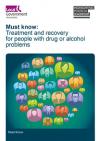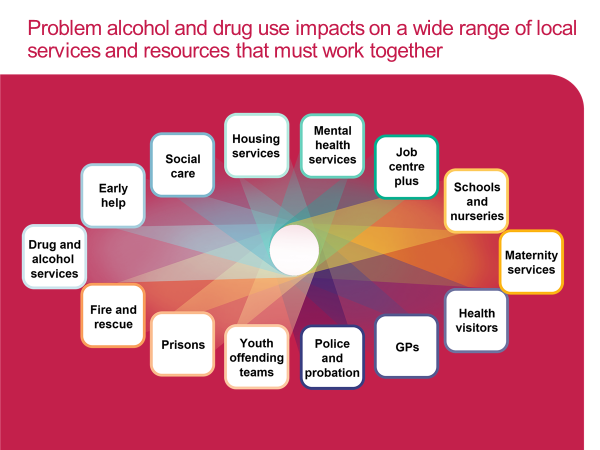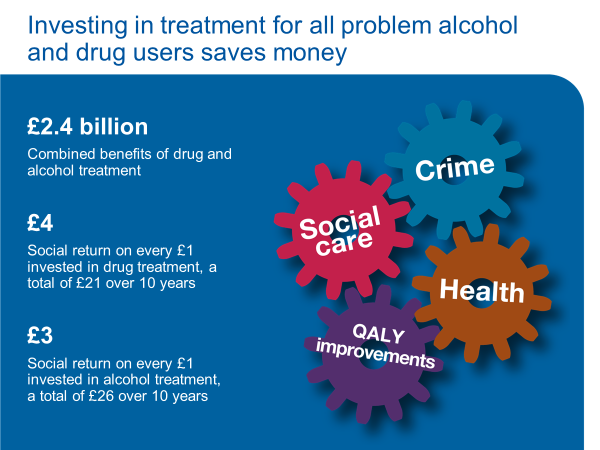
Introduction
People with untreated drug and alcohol dependencies have a disproportionate impact on our communities.
In an average secondary school in England 40 pupils will be living with a parent with a drug or alcohol problem. About one in six Child in Need assessments carried out by local authorities last year record parental alcohol problems, with a similar proportion for drug use. And problem parental alcohol or drug use were each recorded in over a third (36 per cent) of serious case reviews where a child died or was seriously harmed.
Last year 17,000 households assessed by local authorities as being statutorily homeless were recorded as being drug dependent, with 12,500 assessed as alcohol dependent.
Almost half of homicides every year are drug-related, and in almost a fifth, the suspect is under the influence of alcohol. Nearly half of acquisitive crime is drug-related and one-third of the people in our prisons committed drug-related crimes, including acquisitive crime. Analysis by the Ministry of Justice shows that over half (58 per cent) of offenders had been drinking at the time of the offence, and a third (32 per cent) said their offending was connected to their alcohol use.
More people die from drug misuse every year than from all knife crime and road traffic incidents combined. And more working years of life are lost in England as a result of alcohol-related deaths than deaths from cancer of the lung, bronchus, trachea, colon, rectum, brain, pancreas, skin, ovary, kidney, stomach, bladder and prostate, combined.
Local authorities commission drug and alcohol treatment services through the Public Health Grant. It is a condition of the 2021/22 grant that local authorities improve the take up of, and outcomes from, its drug and alcohol misuse treatment services, based on an assessment of local need and a plan which has been developed with local health and criminal justice partners.
These services, working in partnership with other local services, can and do help thousands of people to stabilise and turn their lives around every year; reducing the risks to the individuals, their families and wider community and the burden on a range of other local services. Every pound spent on drug treatment saves at total of £21 over the course of ten years.
Key facts
Drugs
In 2016/17, consumers in England and Wales spent approximately £9.4 billion on illicit drugs. This makes revenue from the drugs industry greater than the UK revenue of such household names as Alidi, Boots or EasyJet.
- The harms from drug misuse cost society £19.3 billion per year, 86 per cent of which is attributable to the health and crime-related costs of the heroin and crack cocaine markets.
- In 2019-20 approximately 3 million adults in England and Wales used illegal drugs. Of these, over half a million (588,000) reported drug use at least once a week.
- Drug use by children aged 11-15 has increased by over 40 per cent since 2014, following a long-term downward trend. Two in five (38 per cent) of 15 year olds report having taken drugs at least once in their lives.
- There were 160,000 adults receiving treatment for drug problems in local authority commissioned services between April 2019 and March 2020. Of these 141,000 were being treated for opiate problems.
- The number of reported county lines has quadrupled in three years and the numbers of children and young people getting drawn into this horrific exploitation continues to grow. In 2020 referrals of children suspected to be victims of county lines increased by 31 per cent.
- Half of adults starting drug treatment are parents – while many don’t currently live with their children there were 19,000 children living with adults who started drug treatment last year.
- There were over 14,000 young people under the age of 18 years in contact with alcohol and drug services between April 2019 and March 2020. This is a 3 per cent reduction on the number the previous year and a 42 per cent reduction on the number in treatment since 2008 to 2009.
Alcohol
- There are around 10 million adults in England who drink above the UK Chief Medical Officers’ low risk guidelines, including more than two million who drink at higher risk and an estimated 587,000 who are dependent on alcohol.
- The 4 per cent of the population who drink the most heavily are estimated to drink a third of all alcohol consumed in England. Their drinking is estimated to contribute 23 per cent of all of the alcohol industry’s revenue
- There were 358,000 hospital admissions in 2018-19 where the primary diagnosis was a condition related to alcohol consumption, including 22 thousand for alcoholic liver disease and 41 thousand for mental and behavioural disorders.
- 22 per cent of 15 year olds reported having been drunk at least once in the last four weeks, and of these a quarter (23 per cent) had vomited.
- 105,000 people with alcohol problems were receiving treatment in local authority commissioned services last year, of whom 30,000 had non-opiate drug problems alongside their alcohol issues.
- Half of those starting alcohol treatment last year were parents, while many don’t currently live with their children, there were 31,000 children living with an adult who started alcohol treatment last year.
- The median drinker in treatment was consuming 400 to 599 units in the four weeks prior to starting treatment – this is the equivalent of between 10 and 15 litres of vodka. One in ten (9.7 per cent) drank over 1,000 units in the four weeks before they started treatment.
What investment has the government made to support drug and alcohol treatment?
The bulk of government investment in drug and alcohol treatment comes through the public health grant. Local authorities reported spending £623 million on drug and alcohol treatment in 2019-20, about a fifth of the public health grant for that year.
Funds for the NHS pay for the commissioning of drug and alcohol treatment in prisons, where last year 52,891 people received support for drug and alcohol problems – half of whom said they had a problem with opiate use.
Elected members as systems leaders
As elected members, you are ideally placed to champion this investment into reducing drug and alcohol harm in your local area, engaging the local community and collaborating with officers.
Your understanding of local communities will enable you to work effectively with officers to ensure that the existing and new funding is applied to meet the needs of local people. This will be vital in achieving the ambition for radically reducing the harms that drugs and alcohol do to our communities.
The provision of active involvement and ongoing and visible support will send a clear signal that tackling drug and alcohol problems is a priority for the local area. The commitment and support of members will also help to ensure that sufficient time and resource will be available to maintain momentum.
The benefits of treating drug or alcohol dependence
Drug and alcohol treatment reduces the burden on local authority services. Dame Carol Black’s independent review estimates the costs of drug use to social care at £630 million a year and noting that treatment for dependent drug users can reduce the cost of drug related social care by 31 per cent.
PHE estimate that there are over 310,000 adults who are dependent on opiates (mainly heroin) and crack cocaine, and about 600,000 who are dependent on alcohol. Most are not being treated for their addiction – about half of opiate and crack users (OCUs) and only one in five dependent drinkers.
Being in treatment reduces offending behaviour – up to half for alcohol users – reduces drug and alcohol related deaths, and the spread of blood borne diseases such as Hepatitis C.
Key questions for members
Resources for further information
Independent review of drugs by Professor Dame Carol Black – part 1 focuses on the ways in which drugs are fuelling serious violence and part 2 covers treatment, recovery and prevention
Helping to support and transform the lives of people affected by drug and alcohol problems – LGA (2018) – case studies showing how local authorities are supporting people with drug and alcohol problems
Alcohol and drug misuse and treatment statistics – PHE – statistics to support improvements in decision making when planning alcohol and drug misuse treatment services
Misuse of illicit drugs and medicines: applying All Our Health – PHE - evidence and guidance to help health professionals identify, prevent or reduce drug-related harm
Statistics on alcohol – NHS Digital – an annual report on a range of information relating to alcohol use and misuse drawn from a variety of sources for England
Statistics on drug misuse – NHS Digital – information on hospital admissions attributable to drugs
Public Health Dashboard – PHE – tool to support local decision-making by bringing existing comparative data into one place, including drug and alcohol treatment.
Parents with alcohol and drug problems: support resources – PHE – resources to support understanding of the extent of problem parental alcohol and drug use and support needs in a local area


